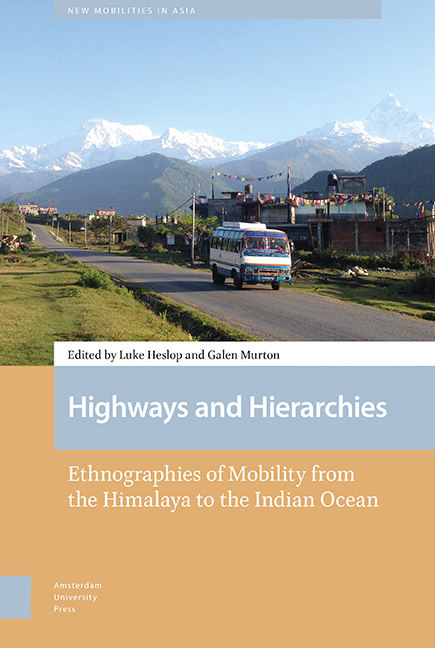Book contents
- Frontmatter
- Contents
- List of figures
- Acknowledgements
- Preface: Thinking with roads
- 1 Why highways remake hierarchies
- 2 Stuck on the side of the road: Mobility, marginality, and neoliberal governmentality in Nepal
- 3 A road to the ‘hidden place’: Road building and state formation in Medog, Tibet
- 4 Dhabas, highways, and exclusion
- 5 The edge of Kaladan: A ‘spectacular’ road through ‘nowhere’ on the India-Myanmar borderlands
- 6 The making of a ‘new Dubai’: Infrastructural rhetoric and development in Pakistan
- 7 Encountering Chinese development in the Maldives: Gifts, hospitality, and rumours
- 8 Roads and the politics of thought: Climate in India, democracy in Nepal
- Authors notes
- Index
5 - The edge of Kaladan: A ‘spectacular’ road through ‘nowhere’ on the India-Myanmar borderlands
Published online by Cambridge University Press: 13 November 2021
- Frontmatter
- Contents
- List of figures
- Acknowledgements
- Preface: Thinking with roads
- 1 Why highways remake hierarchies
- 2 Stuck on the side of the road: Mobility, marginality, and neoliberal governmentality in Nepal
- 3 A road to the ‘hidden place’: Road building and state formation in Medog, Tibet
- 4 Dhabas, highways, and exclusion
- 5 The edge of Kaladan: A ‘spectacular’ road through ‘nowhere’ on the India-Myanmar borderlands
- 6 The making of a ‘new Dubai’: Infrastructural rhetoric and development in Pakistan
- 7 Encountering Chinese development in the Maldives: Gifts, hospitality, and rumours
- 8 Roads and the politics of thought: Climate in India, democracy in Nepal
- Authors notes
- Index
Summary
Abstract
Using the case of India's mega-infrastructure build-up, the Kaladan Multimodal Transport Project (KMMTP) in the ‘remote’ and ethnically contentious borderlands between India and Myanmar, this chapter takes an ethnographic approach to understand the meaning of spectacular connectivity and infrastructure on remote borderlands. Based on six months of fieldwork, the chapter explores the voices, visions, spatial and ethnic worlds of border residents who subsequently have to position themselves and their remoteness to absorb the Indian state's spectacular new connective infrastructure. The chapter narratively traverses along this newly constructed road, to the very edge of a hitherto informal and flexible border with Myanmar. In doing so, it highlights the need to investigate the banal, unspectacular and interethnic lived realities of the borderland. The chapter argues that spectacular infrastructures such as the KMMTP are harnessed in the pursuit of territorial control, making the remote legible and for extracting profits. The chapter introduces the analytic of the ‘spectacle’ to demonstrate how powerful states and ethnic communities rely on grand infrastructural spectacles and cross-border projects often at the expense, erasure and displacement of those at the edge of borderlands, who have the least stake in shaping such spectacular infrastructures.
Keywords: India, Myanmar, Kaladan, spectacle, remoteness, infrastructure
Introduction: A road through ‘nowhere’ from India to Myanmar
Borderlands and frontiers have always been the archetypal ‘remote’ place in popular imagination yet they rarely vanish from the powerful gaze of empire rulers and state leaders. In the past, imperial courts tried to rein them in and colonial merchants wished to market them. Today, state authorities hope to govern them, zoning the peripheries as transformative spaces responsive to development agendas and new sovereign orders.
– Zhang (2014: 376)On a late winter night in 2015, we arrived in the quiet town of Lawngtlai after an arduous seventeen-hour road journey from Aizawl, the capital of Mizoram state, in Northeast India. Sparsely populated, it was a cold, whispery district sitting at 1132 feet above sea level bordering Chin State in Myanmar to the south and the Chittagong Hill Tracts in Bangladesh to the west.
- Type
- Chapter
- Information
- Highways and HierarchiesEthnographies of Mobility from the Himalaya to the Indian Ocean, pp. 125 - 154Publisher: Amsterdam University PressPrint publication year: 2021
- 1
- Cited by



